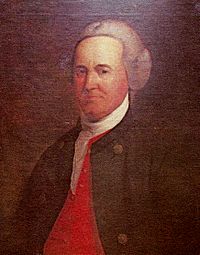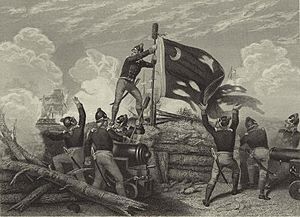Snow Campaign facts for kids
Quick facts for kids Snow Campaign |
|||||||
|---|---|---|---|---|---|---|---|
| Part of the American Revolutionary War | |||||||
 General Richard Richardson |
|||||||
|
|||||||
| Belligerents | |||||||
| Commanders and leaders | |||||||
| Andrew Williamson Richard Richardson William Thomson |
Patrick Cuningham Thomas Fletchall |
||||||
| Strength | |||||||
| 5,000 men (peak size) | 400 men (peak size) | ||||||
| Casualties and losses | |||||||
| unknown | 6 killed, 130 captured | ||||||
The Snow Campaign was an important military event during the American Revolutionary War. It happened in the southern colonies, mainly South Carolina, in late 1775. An army of up to 3,000 Patriot fighters, led by Colonel Richard Richardson, marched against areas where Loyalists were gathering. Loyalists were people who wanted to stay loyal to the British King. The Patriots stopped the Loyalists from organizing their forces. This campaign got its name because of a heavy snowfall that happened near the end.
Contents
Why the Snow Campaign Started
When the American Revolutionary War began in April 1775, people in South Carolina had different ideas. Many people living near the coast, especially English settlers, either didn't pick a side or supported the rebellion. But many people in the backcountry, including German and Scottish immigrants, were against the rebellion.
A strong Loyalist leader in the backcountry was Thomas Fletchall. He openly spoke against resisting the King. By August 1775, feelings between Patriots and Loyalists grew very tense. Both sides had gathered large groups of militia (citizen soldiers).
For a while, things were mostly peaceful, but people were very worried. Both sides wanted to control weapons and supplies. The Patriot Council of Safety tried to get more support for the Patriots. They also wanted to stop Loyalist activities in the backcountry. In September, a temporary agreement was made with Fletchall, but it didn't last long.
On September 15, Patriot militia took control of Fort Johnson. This fort protected the Charleston harbor. The British Governor, William Campbell, left the area because he feared for his safety. He went to a British Navy ship. This meant the Council of Safety was now in charge of Charleston. They started making Charleston's defenses stronger. There were some exchanges of cannon fire between Patriot positions and British ships in November, but no one was hurt.
Things got more serious when Loyalists took a shipment of gunpowder and ammunition in October. This shipment was meant for the Cherokee people. On November 8, the Council of Safety decided to act. They sent Colonel Richard Richardson to get the supplies back and arrest the Loyalist leaders.
The Siege at Ninety Six
While Colonel Richardson was gathering his forces, Major Andrew Williamson was recruiting Patriots in the backcountry. He learned about the stolen gunpowder. On November 19, he arrived at Ninety Six with 560 men.
Ninety Six was a small town, not easy to defend. So, Williamson set up a camp on John Savage's farm. This camp had a makeshift stockade (a fence of strong posts) and three small cannons. Williamson also learned that Captain Patrick Cuningham and Major Joseph Robinson were leading a large Loyalist force, about 1,900 men, toward Ninety Six. The Patriot leaders decided not to march out and fight them. The Loyalists arrived the next day and surrounded the Patriot camp. This event is known as the Siege of Savage's Old Fields.
The leaders of both sides were trying to talk things out. But then, Loyalists captured two Patriot soldiers outside the camp. This started a gunfight that lasted about two hours. A few people were hurt on both sides. For two more days, the Patriots were surrounded, with occasional shooting. The siege ended when the Patriot leaders agreed to leave their camp. In return, they gave up their small cannons, which were later returned. Both sides then left. The Loyalists went across the Saluda River, and the Patriots headed toward Charleston.
Patriots Chase Loyalists
Colonel Richardson had started his march into the backcountry. By November 27, he reached the Congaree River with about 1,000 men. He stopped there for a few days, crossing the river and gathering more militia groups. When he left, his force had grown to about 1,500 men.
By December 2, he reached the Dutch Fork area, which is between the Saluda and Broad Rivers. He kept gathering more militia along the way. He stopped at Evan McLauren's house and captured several Loyalist officers. The Loyalist forces were getting smaller because their leaders were gone, and many soldiers were leaving. The remaining Loyalists retreated toward Cherokee lands.
Richardson then announced that Loyalist officers should be arrested and the stolen supplies returned. His army, now about 2,500 strong, continued to grow. They marched toward the Enoree River, chasing Loyalist leaders. On December 12, Richardson reported that his force had reached 3,000 men. He had captured Fletchall, who was found hiding in a cave, and other Loyalist leaders. Fletchall's farm was searched, and letters from Governor Campbell were found.
At the Enoree River, Richardson's army grew even larger. Major Williamson's militia joined him, along with more militia from North Carolina. These North Carolina forces were led by Colonels Griffith Rutherford and William Graham. Richardson's total force now had between four and five thousand men.
These large Patriot forces searched the backcountry. They found a camp of 200 Loyalists on the Reedy River, deep inside Cherokee territory. Richardson sent William Thomson with 1,300 troops to attack this camp. Thomson and his volunteers surprised the Loyalist camp on December 22. They took prisoners and seized supplies, weapons, and ammunition. This fight was called the Battle of Great Cane Brake. Only five or six Loyalists were killed, and one of Thomson's men was wounded.
The next day, December 23, it started snowing as the Patriot forces headed back to the coast. The march home was very difficult because the soldiers were not ready for the cold weather. Richardson's army then broke up, and most of the Patriots went home. Richardson took 136 prisoners, who were sent to Charleston on January 2, 1776.
What Happened Next

Governor Campbell stayed on his ship, the Tamar. He thought about attacking Fort Johnson after another warship arrived. But Patriot forces were busy making the harbor's defenses stronger. The British fleet left Charleston in January 1776.
British forces, led by Sir Henry Clinton, tried to attack Charleston in June 1776. This attack, known as the Battle of Sullivan's Island, was not successful. It was the last major British operation in the south until late 1778.
The Snow Campaign stopped most large-scale Loyalist activity in the backcountry. Most of the prisoners taken were later set free by the Patriot leaders. This was done to try and make peace with their Loyalist neighbors. Some Loyalist leaders did manage to escape. One of them was Thomas Brown. He was a South Carolina landowner who fled to East Florida. He became a key leader in the fighting along the Georgia-Florida border. His plans to retake Georgia and South Carolina were used by the British between 1778 and 1780.

